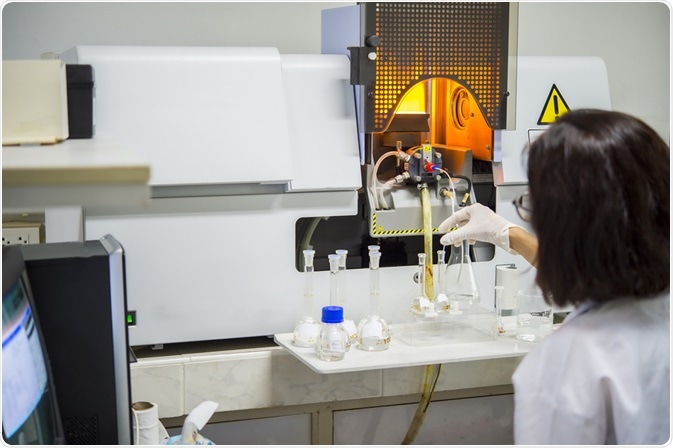Atomic spectroscopy is comprised by a wide number of analytical techniques that rely on diverse principles, and also have an extensive variety of applications.

Image Credit: Rabbitmindphoto/Shutterstock.com
Nevertheless, the common denominator with the aforementioned techniques is that they all have the capability of obtaining elemental chemical information from the samples of interest. This feat is achieved by studying/monitoring the electromagnetic radiation, which is absorbed and emitted by the atoms of the sample.
Classification of Atomic Spectroscopies
The atomic spectroscopy techniques can be categorized into three main groups based on the type of particle they can detect. 1)
Optical spectroscopy: The intensity of the non-absorbed photons or the emitted photons is monitored as a function of photon energy (Optical spectroscopy could be further classified into atomic absorption and atomic emission spectroscopy). Fluorescence spectroscopy would be a prime example of an optical spectroscopy technique. 2)
Electron spectroscopy: This measures the kinetic energy of electrons that are ejected from an excited (usually with the help of a flame) sample. An example of an electron spectroscopy-based technique would be X-ray photoelectron spectroscopy (XPS). 3)
Mass spectroscopy (MS): The different atomic ions are expressed as mass to charge ratios and their abundance is determined by the number of ions that were detected. A widely used technique that relies on Mass spectroscopy is Inductive Couple Plasma (ICP) – MS.
The Selectivity of Atomic Spectroscopies
There are many sources of erroneous data when using any of the atomic spectroscopy techniques. Therefore, it is crucial to have a firm grasp of these potential pitfalls and how they can be circumvented.
Errors due to spectral complications: Complex spectra are encountered frequently, and they pose a great challenge every time due to the spectral lines overlapped by the spectral lines of other major elements. This phenomenon can be overcome by using high-resolution spectrometers. Another option would be to focus on different spectral lines.
Errors due to physical changes: Particularly relevant for liquid samples. Any changes in the solvent, viscosity, and surface tension will in turn affect the nebulization and the final density of the atoms of the analyte in the atomizer.
Errors due to chemical changes: This happens often when low-temperature atomizers are used (flames and graphite furnaces); analyte refractory compounds are sometimes formulated. The reduction of the analyte atoms will affect the analytical signal. A way to tackle this issue would be the use of an atomizer that can reach a higher temperature or resort to using chemical reagents that can interact with the analyte, forming molecules that can be easily dissociated when the atomizer is unable to reach very high temperatures.
Applications of Atomic spectroscopy
A great analytical chemistry tool for determining metals and metalloids in a solvent is atomic absorption spectroscopy (AAS). This technique is sensitive enough and suffers from relatively little interference (errors in the data). The same technique can be used effectively in Forensic science.
When a bulk analysis of gunshot residue is required, AAS is ideal due to its unique ability to determine lead, antimony, and barium content. Moreover, inductive coupled plasma atomic emission spectroscopy has been used with success for similar tasks; however, it is not used widely due to the cost of the instrument.
Food analysis nowadays also relies on an atomic spectroscopy technique. ICP-MS is used for the elemental analysis of food after the technique gained ground quickly in the mid-1980s. It is especially used in food industries to ensure compliance with regulations and for general quality control. However, it is still a relatively expensive technique, mainly due to the high costs of its consumables and its general maintenance.
XPS has found extensive use in the study of textile surfaces. It is a qualitative technique for measuring the elemental composition of surfaces up to a depth of 10nm, therefore XPS is ideal for the investigation of plasma-treated textiles such as acrylics and cotton, and general surface modification of all kind of textiles.
Additionally, XPS can be a powerful tool when it comes to analyzing graphene, which is currently a very popular research topic due to the multitude of graphene’s applications (e.g. solar cells, medical uses, electronic circuits). XPS can highlight the differences of graphene before and after chemical modification, which makes it an ideal method for confirming the addition of a functional group to a graphene structure.
Moreover, the number of graphene layers can be determined along with any impurities that may hinder further chemical modifications. Overall, the rapid advancements of technology are making the use of atomic spectroscopy techniques much more frequent and more accessible to a larger number of scientists. That in turn facilitates an increasing number of new useful applications for atomic spectroscopy techniques.
References
- Alfredo Sanz-Medel, Rosario Pereiro, Jose M Costa-Fernandez, A General Overview of Atomic Spectrometric Techniques, RSC Analytical Spectroscopy Series, 2009
- Francesco Cubadda, in Food Toxicant Analysis, 2007
- S.W. Lewis, K.M. Agg, S.J. Gutowski, P. Ross, in Encyclopedia of Analytical Science (Second Edition), 2005
- Steve J. Hill, Andy S. Fisher, in Encyclopedia of Spectroscopy and Spectrometry (Third Edition), 2017
- Owen J. Guy, Kelly-Ann D. Walker, in Silicon Carbide Biotechnology (Second Edition), 2016
Last Updated: Oct 21, 2020